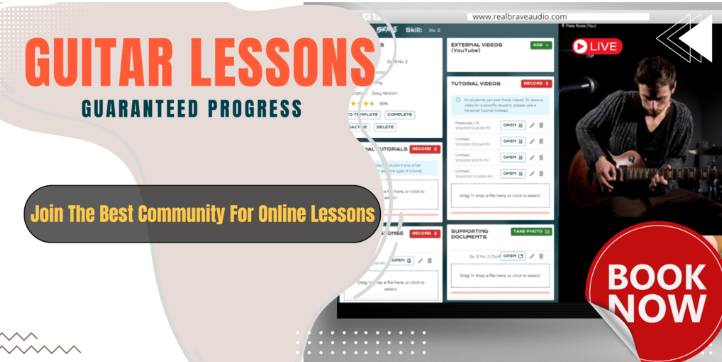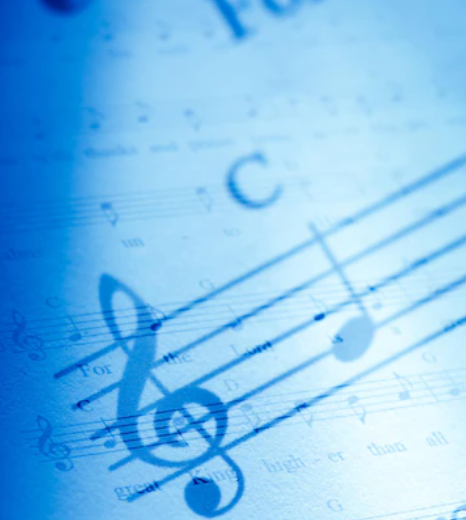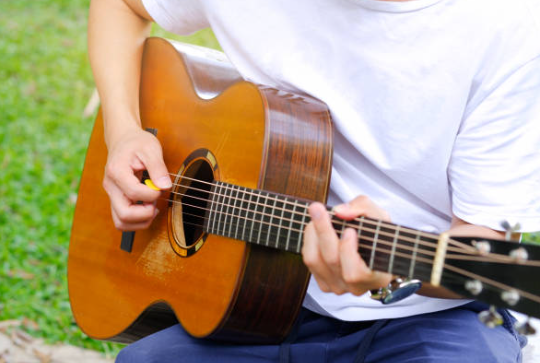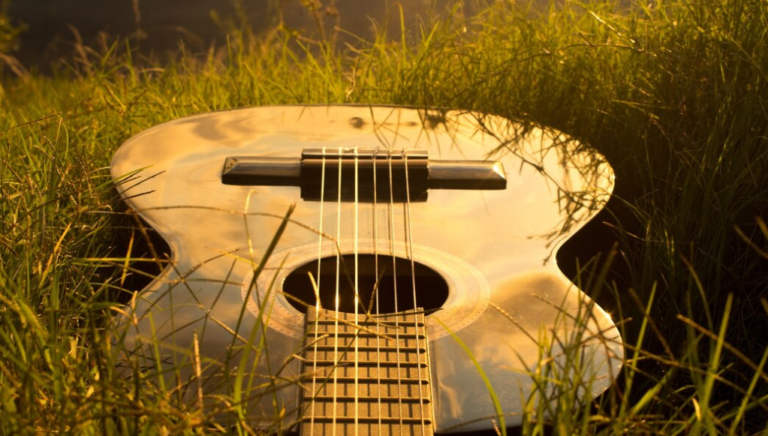What You Need To Know About How To Play the E Power Chord
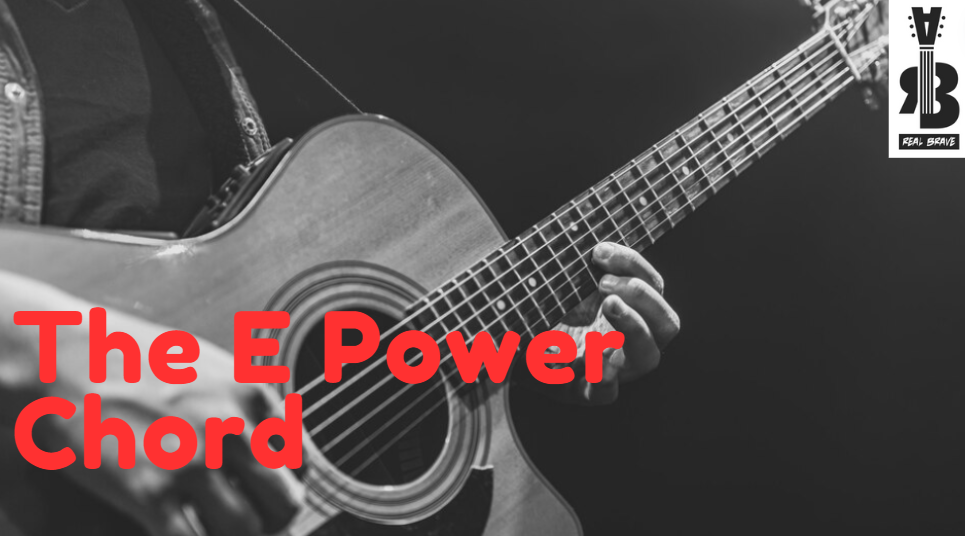
Learning to play the guitar is an exciting journey filled with endless possibilities for musical expression. Among the foundational techniques every guitarist must master is the art of playing power chords. These simple yet powerful chords form the backbone of countless rock, punk, and metal songs, making them essential for any aspiring musician to learn.
In this blog, we’ll focus on one of the most fundamental power chords: the E power chord. Whether you’re a beginner just starting or an experienced player looking to hone your skills, mastering the E power chord opens up a world of musical potential.
Throughout this guide, we’ll break down the E power chord step by step, providing clear explanations, practical tips, and effective exercises to help you become proficient in playing this essential chord shape. By the end, you’ll not only have a solid understanding of how to play the E power chord but also the confidence to incorporate it into your playing repertoire with ease.
So, grab your guitar, tune up, and dive into the world of the E power chord!
Anatomy of the E Power Chord
The E Power Chord’s Composition
The E power chord, or E5, consists of two notes: the root note (E) and the perfect fifth (B). Unlike major or minor chords, power chords lack the third interval, giving them a neutral, ambiguous sound that works well in various musical contexts. This simplicity makes power chords versatile and easy to play, especially for beginners.
Fingering Technique on the Guitar Fretboard
To play the E power chord, start by placing your index finger on the second fret of the A string (5th string), which is the note E. Then, either use your ring or pinky finger to press down on the fourth fret of the D string (4th string), which is the note B. Strumming these two strings together creates the distinct sound of the E power chord. Alternatively, using a similar finger positioning, you can play the same notes on the low E string (6th string) and A string (5th string).
Playing the E Power Chord
E Power Chord – Root Note on the A string
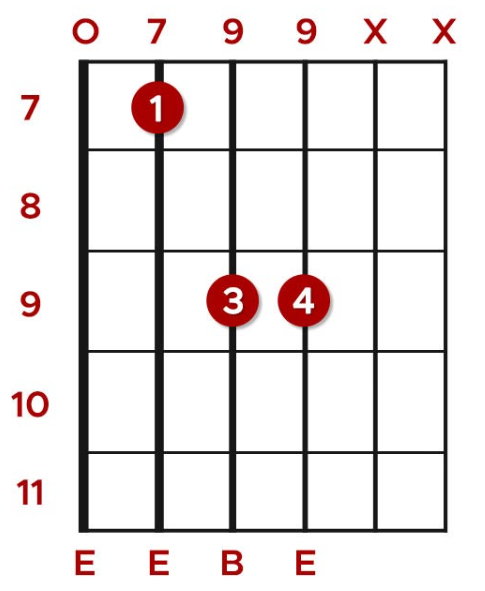
- Place your first finger (index) on the 7th fret of the A string.
- Place your third finger (ring) on the 9th fret of the D string.
- Place your fourth finger (pinky) on the 9th fret of the G string.
On this chord feel free to also play the Low E note. Do this while mixing in palm muting, downpicking, and distorting to get a typical rock and metal tone.
E Power Chord – Root Note on the Low E string
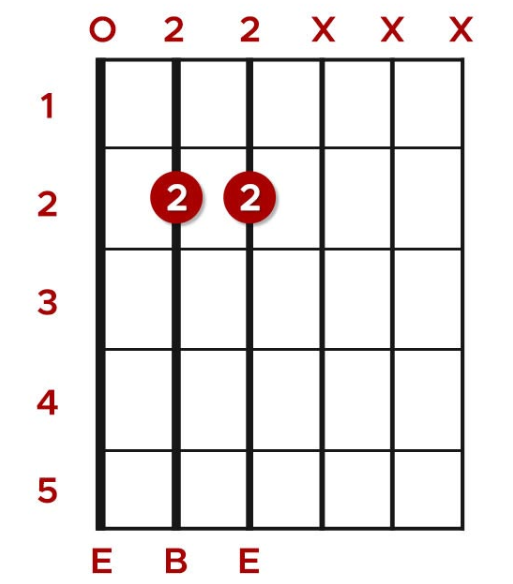
An alternate way of playing an E power chord use the open Low E string to root the chord.
- Place your finger as a bar on the 2nd fret of the A and D strings.
- Play the low E string open.
- Mute the other string and play the Low E, A, and D strings.
This will produce the heaviest sound and it’s also really easy to play. Again, feel free to try this with some distortion as this is a great rock chord to play on electric guitar.
Techniques To Achieve Clear and Consistent Chord Sound
Consistency is key when playing the E power chord. Apply even pressure with your fretting fingers to ensure that each note is fretted firmly and cleanly. Experiment with the placement of your fingers to find the sweet spot where you can fret the notes with minimal effort while still producing a full, resonant sound. When strumming the chord, use controlled motion with your pick or fingers to maintain a steady rhythm and dynamic level. Practice strumming the E power chord at different speeds and intensities to develop control and precision in your playing.
Common Mistakes to Avoid When Playing the E Power Chord
As you practice the E power chord, be mindful of common mistakes that can hinder your progress. Avoid pressing too hard on the strings, as this can cause unnecessary tension in your hand and lead to fatigue. Instead, focus on applying just enough pressure to fret the notes cleanly without straining your fingers. Watch out for unintentional muting of strings with your palm or fingers, which can result in a muted or muffled chord sound. If you encounter these issues, take a moment to adjust your hand position and finger placement to ensure that all strings are free to vibrate and produce sound. With patience and persistence, you can overcome these challenges and master the E power chord with confidence.
In this blog, we explored the fundamental technique of playing the E power chord on guitar, essential for aspiring musicians across various genres. Beginning with an introduction to the significance of power chords, particularly the E power chord, we provided a comprehensive breakdown of its composition and demonstrated the fingering technique on the guitar fretboard. Offering practical tips for proper hand positioning, clear chord sound, and common mistakes to avoid, we equipped readers with essential skills for mastering the E power chord. Furthermore, we delved into advanced techniques and variations, including palm muting and chord embellishments, to enhance musical expression. The blog concluded with an encouragement to continue exploring and practicing, fostering confidence and creativity in incorporating the versatile E power chord into one’s musical repertoire.
Interested in taking your guitar skills to the next level? Click the below and book a free lesson with us! We’re committed to helping you express yourself freely on the guitar without endless scales and theory. Happy playing!
Author: Daniel Powers Jr, the founder of Real Brave™, serves as the chief inspiration to thousands of students in the Real Brave music instruction program. He’s also the visionary behind PracticePad™, an online platform for live one-on-one online music lessons, lesson tracking, and scheduling. Beyond his entrepreneurial pursuits, Daniel leads a non-profit organization that provides formerly homeless children with access to music education, making a profound impact on their lives. His unwavering dedication to music, innovation, and education continues to inspire individuals to reach their fullest potential while creating positive change in communities. Follow Real Brave on all the socials:
youtube.com/@realbraveinc
twitter.com/realbraveinc
instagram.com/realbraveaudio
facebook.com/realbraveinc
